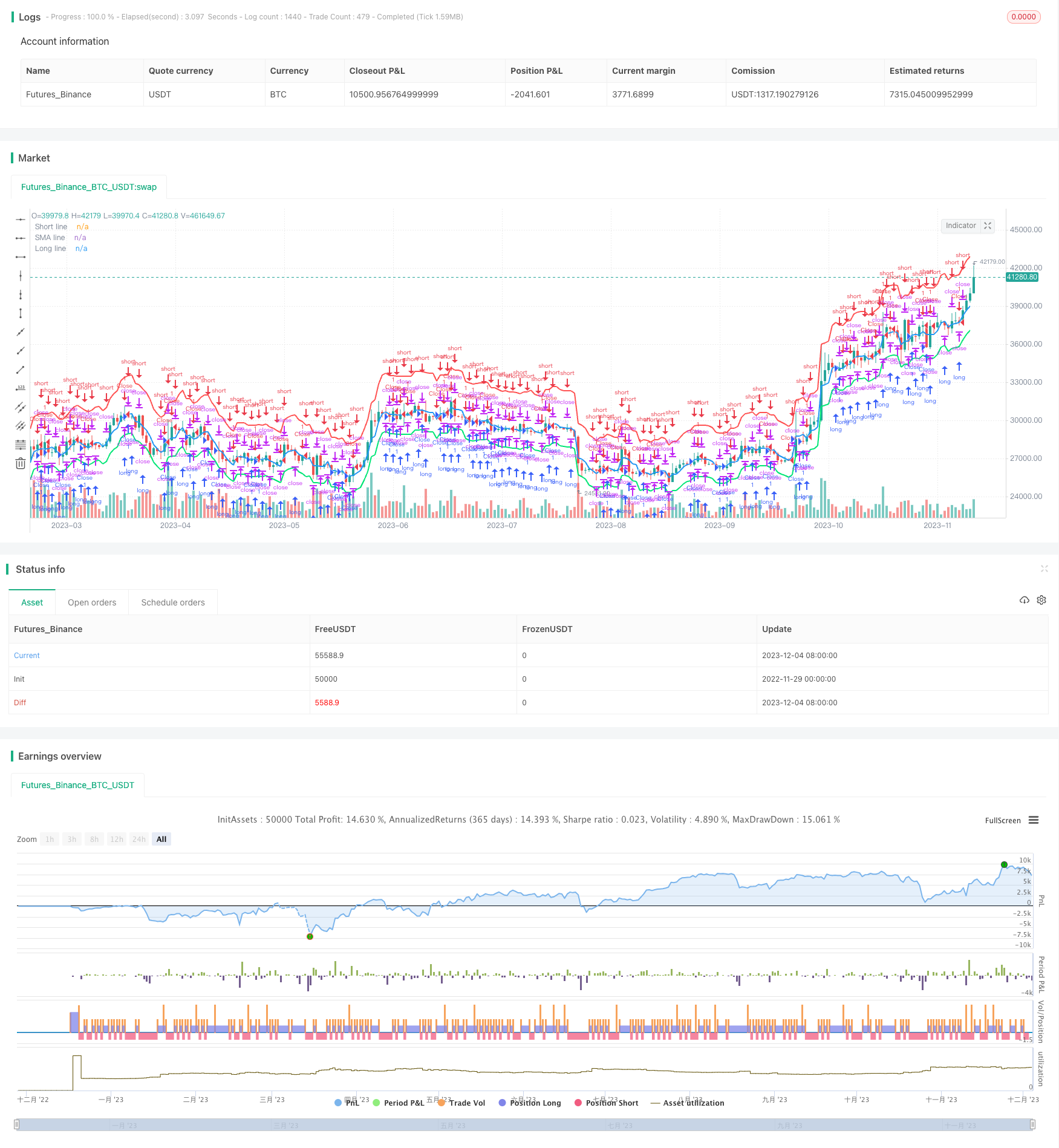
概述
该策略基于价格通道指标,设置了动量参数,通过计算不同周期的最高价和最低价的均值,形成价格通道中线,以此为基准,设置长线和短线。当价格突破长线时,做多;当价格突破短线时,做空。平仓条件为价格回归通道中线。
策略原理
该策略使用价格通道指标计算不同周期内的最高价和最低价的均值,形成价格通道中线。以中线为基准,通过shift参数设置长线和短线。具体来说,长线计算公式为:中线+(中线×长线参数%);短线计算公式为:中线+(中线×短线参数%)。
当价格低于长线时,使用限价单开多单;当价格高于短线时,使用限价单开空单。多空单的止损方式为价格回归通道中线。
优势分析
该策略具有以下优势:
- 使用价格通道指标,可以有效捕捉价格趋势和关键支持阻力位。
- 采用突破记录方式开仓,可以减少假突破带来的亏损。
- 止损方式直接以价格通道中线为标准,避免追价止损带来的过度亏损。
风险分析
该策略也存在一些风险:
- 价格通道参数设置不当,可能错过积极行情或产生过多假突破。
- 突破开仓方式带来一定程度划渡成本。
- 价格快速回落期间,无法及时止损。
可以通过优化参数,设置止损单,或者结合其他指标判断来减轻上述风险。
优化方向
该策略可以从以下几个方面进行优化:
- 优化价格通道的参数,寻找最佳组合。
- 尝试不同的开仓方式,如K线形态、指标多空信号等。
- 增加止损单设置,防止价格快速回落带来的亏损。
- 结合交易量、波动率等指标,避免在 shares市场产生假突破。
总结
本策略基于价格通道指标设计思路清晰,使用突破开仓可以有效控制风险。但也存在参数优化空间较大,止损机制有待完善等问题。总体来说,该策略具有一定的实用价值,值得进一步测试与优化。
策略源码
/*backtest
start: 2022-11-29 00:00:00
end: 2023-12-05 00:00:00
period: 1d
basePeriod: 1h
exchanges: [{"eid":"Futures_Binance","currency":"BTC_USDT"}]
*/
//Noro
//2018
//@version=3
strategy(title = "Noro's PCMA Strategy v1.0", shorttitle = "PCMA 1.0", overlay = true, default_qty_type = strategy.percent_of_equity, default_qty_value = 100, pyramiding = 0)
//Settings
needlong = input(true, defval = true, title = "Long")
needshort = input(true, defval = true, title = "Short")
capital = input(100, defval = 100, minval = 1, maxval = 10000, title = "Lot, %")
per = input(3, title = "Length")
shortlevel = input(10.0, title = "Short line (red)")
longlevel = input(-5.0, title = "Long line (lime)")
fromyear = input(1900, defval = 1900, minval = 1900, maxval = 2100, title = "From Year")
toyear = input(2100, defval = 2100, minval = 1900, maxval = 2100, title = "To Year")
frommonth = input(01, defval = 01, minval = 01, maxval = 12, title = "From Month")
tomonth = input(12, defval = 12, minval = 01, maxval = 12, title = "To Month")
fromday = input(01, defval = 01, minval = 01, maxval = 31, title = "From day")
today = input(31, defval = 31, minval = 01, maxval = 31, title = "To day")
//Price Channel
h = highest(high, per)
l = lowest(low, per)
c = (h + l) / 2
ll = c + ((c / 100) * longlevel)
sl = c + ((c / 100) * shortlevel)
//Lines
shortcolor = needshort ? red : na
longcolor = needlong ? lime : na
plot(sl, linewidth = 2, color = shortcolor, title = "Short line")
plot(c, linewidth = 2, color = blue, title = "SMA line")
plot(ll, linewidth = 2, color = longcolor, title = "Long line")
//Trading
size = strategy.position_size
lot = 0.0
lot := size == 0 ? strategy.equity / close * capital / 100 : lot[1]
if (not na(close[per])) and size == 0 and needlong
strategy.entry("L", strategy.long, lot, limit = ll, when = (time > timestamp(fromyear, frommonth, fromday, 00, 00) and time < timestamp(toyear, tomonth, today, 23, 59)))
if (not na(close[per])) and size == 0 and needshort
strategy.entry("S", strategy.short, lot, limit = sl, when = (time > timestamp(fromyear, frommonth, fromday, 00, 00) and time < timestamp(toyear, tomonth, today, 23, 59)))
if (not na(close[per])) and size > 0
strategy.entry("Close", strategy.short, 0, limit = c, when = (time > timestamp(fromyear, frommonth, fromday, 00, 00) and time < timestamp(toyear, tomonth, today, 23, 59)))
if (not na(close[per])) and size < 0
strategy.entry("Close", strategy.long, 0, limit = c, when = (time > timestamp(fromyear, frommonth, fromday, 00, 00) and time < timestamp(toyear, tomonth, today, 23, 59)))
if time > timestamp(toyear, tomonth, today, 23, 59)
strategy.close_all()